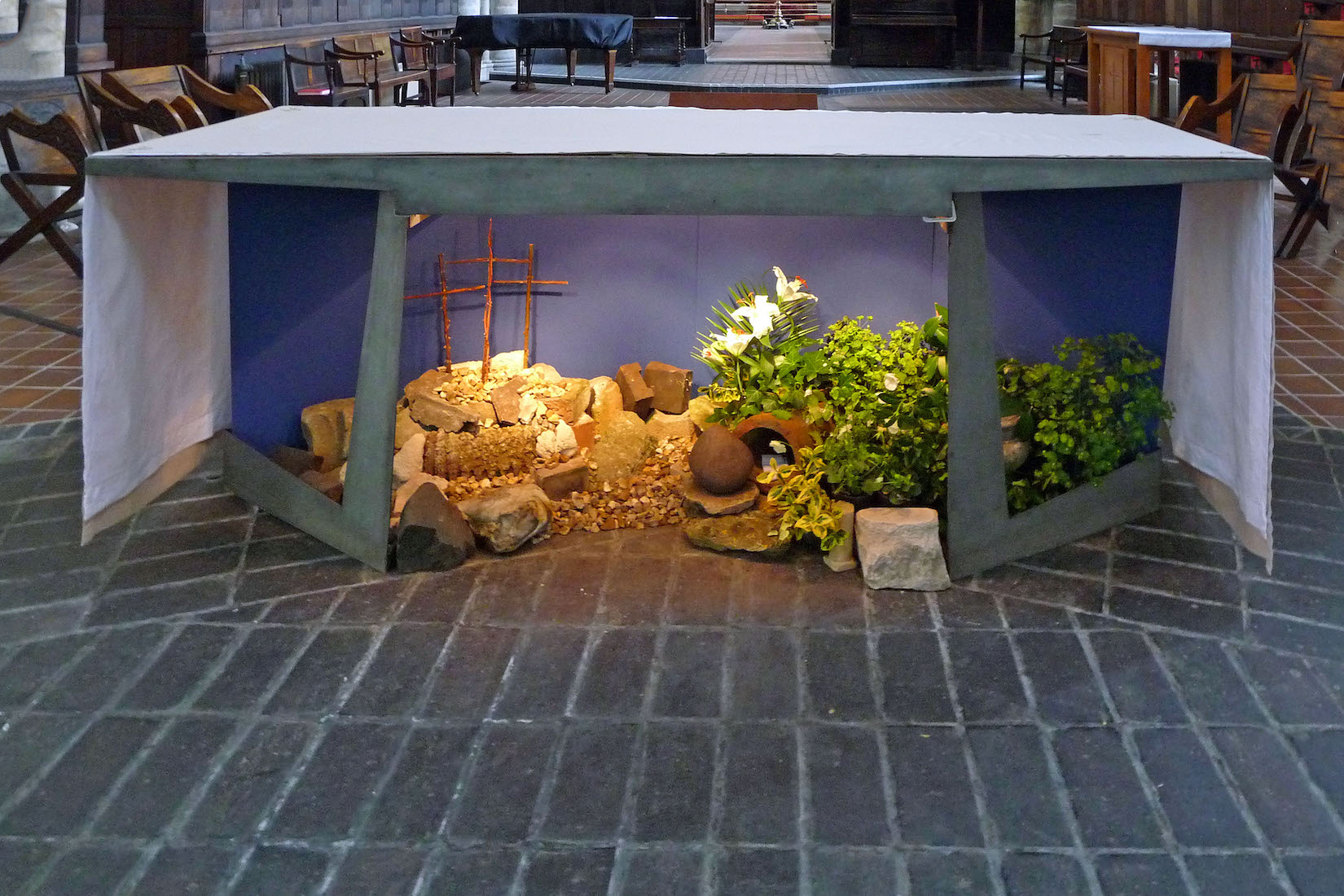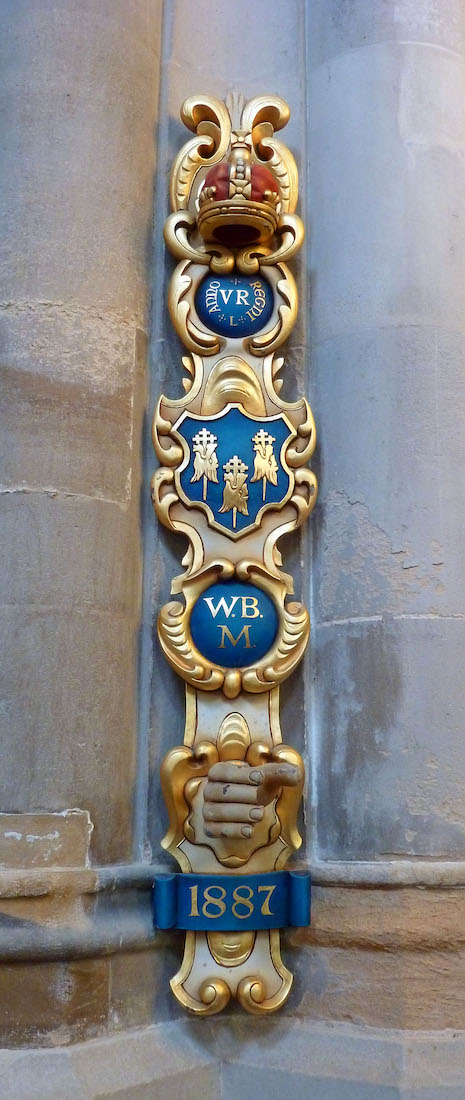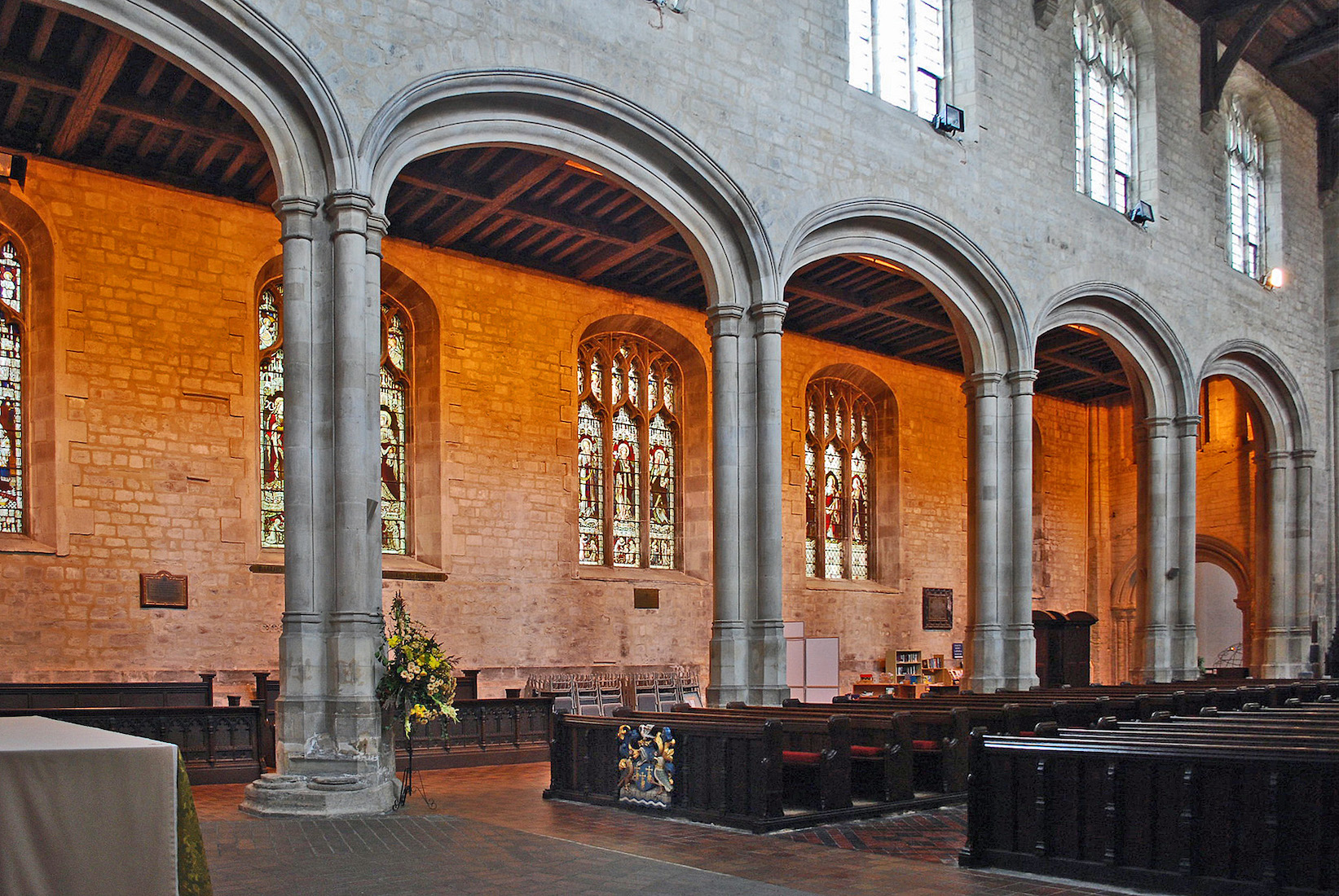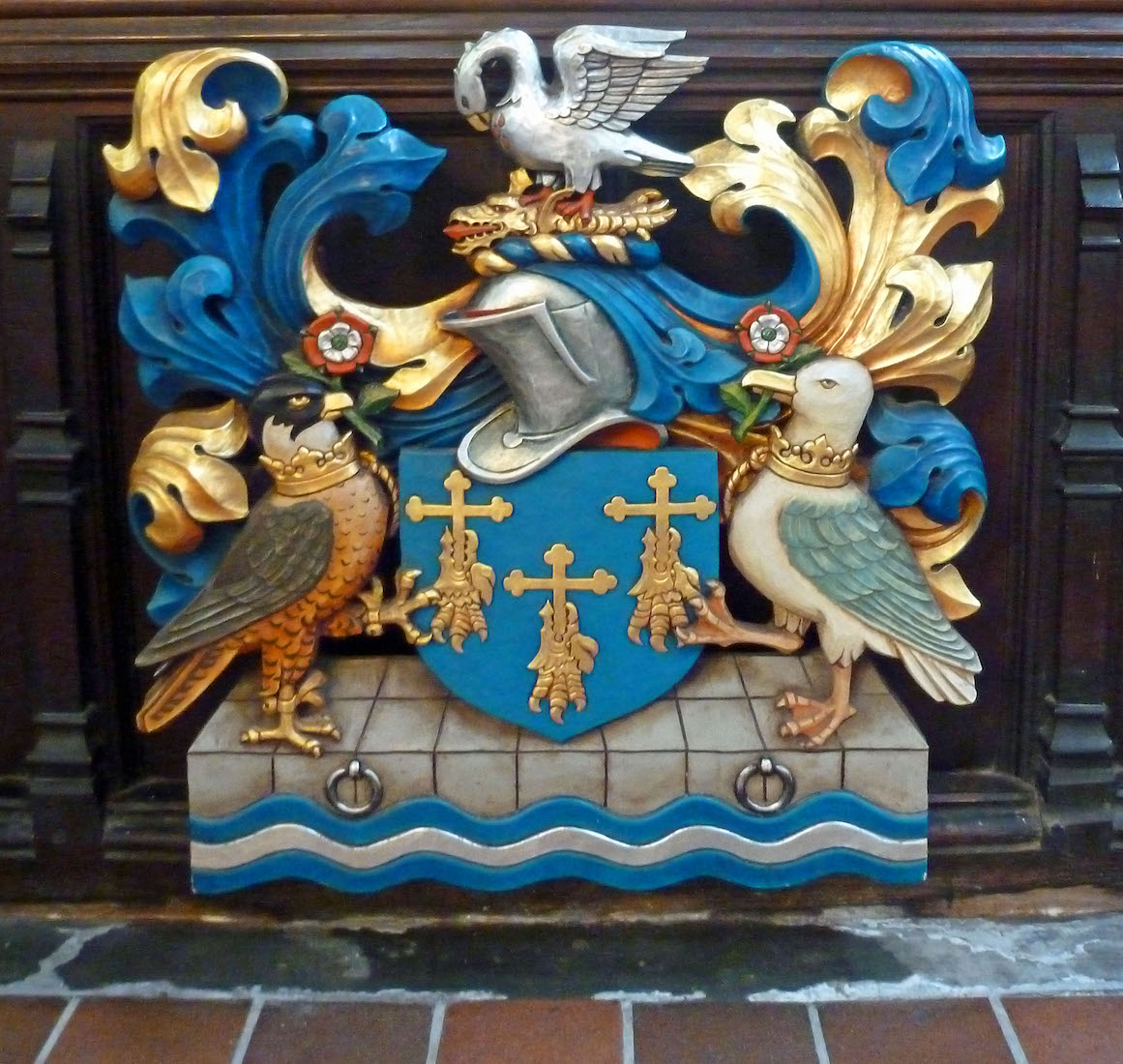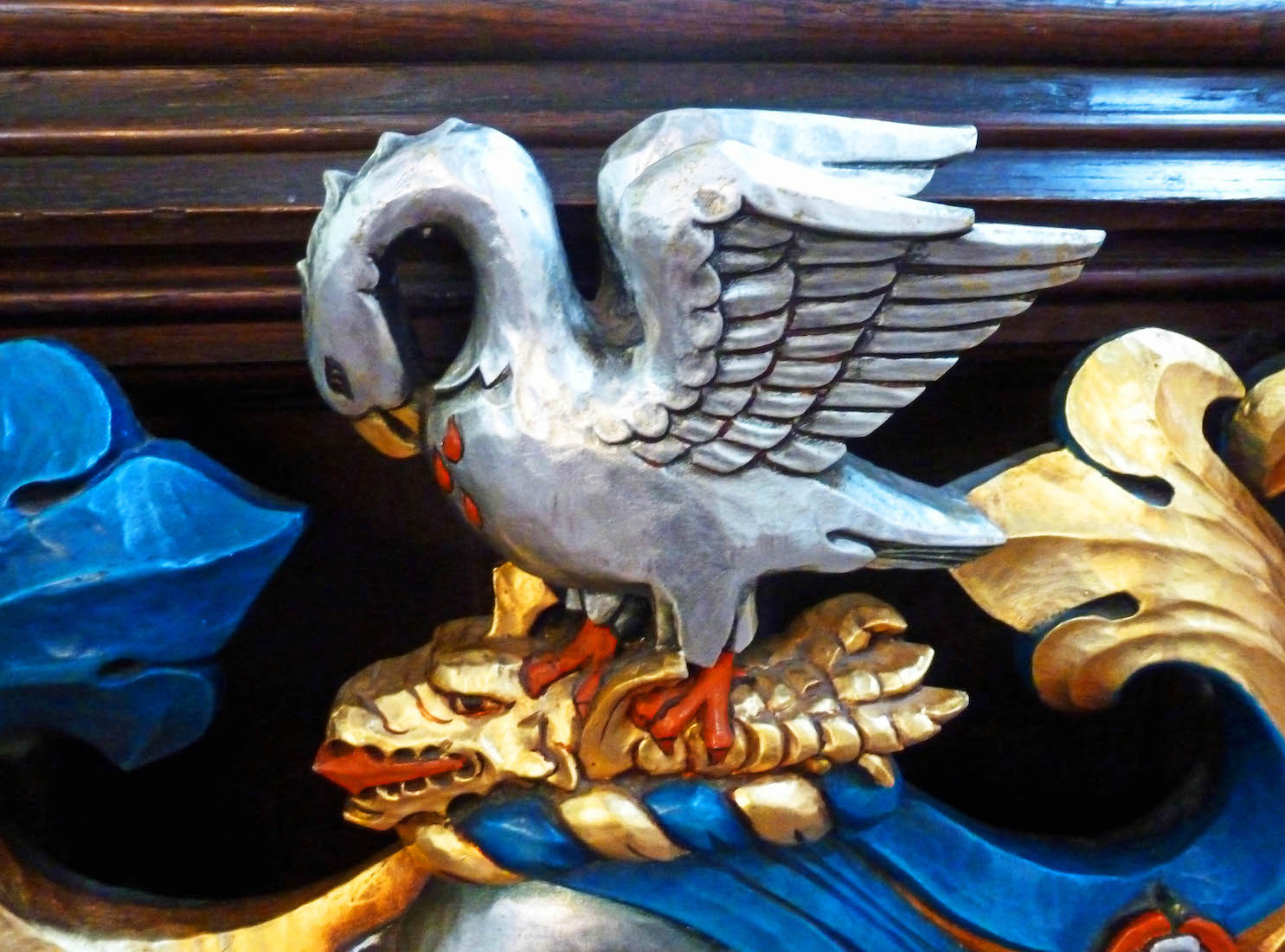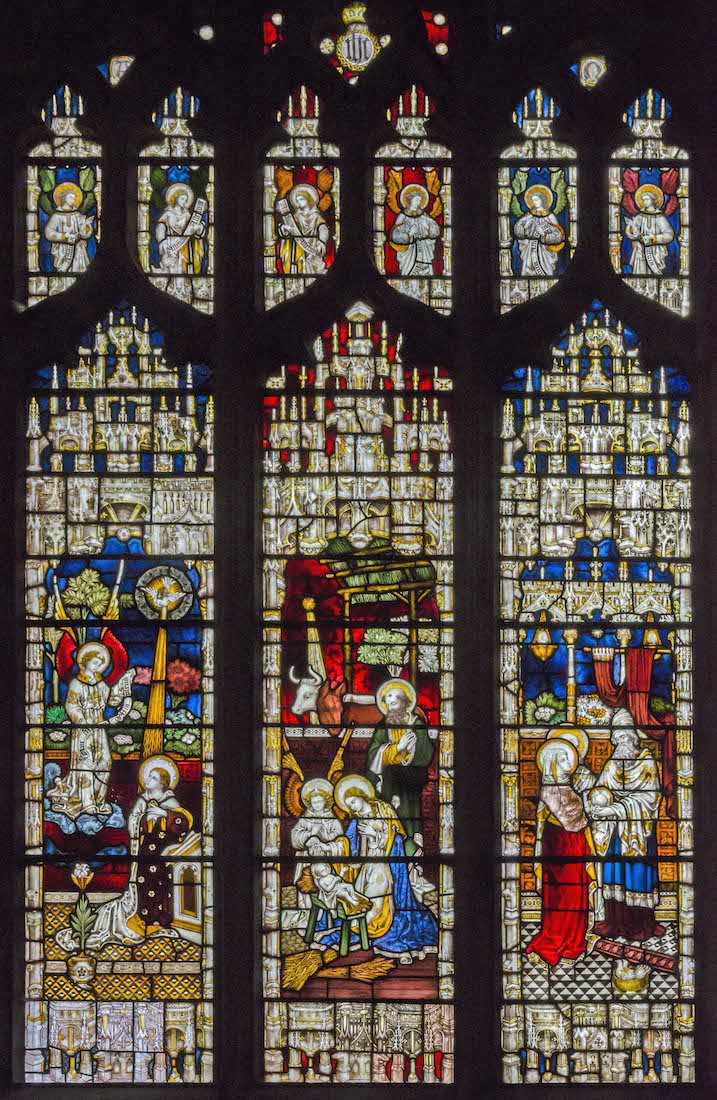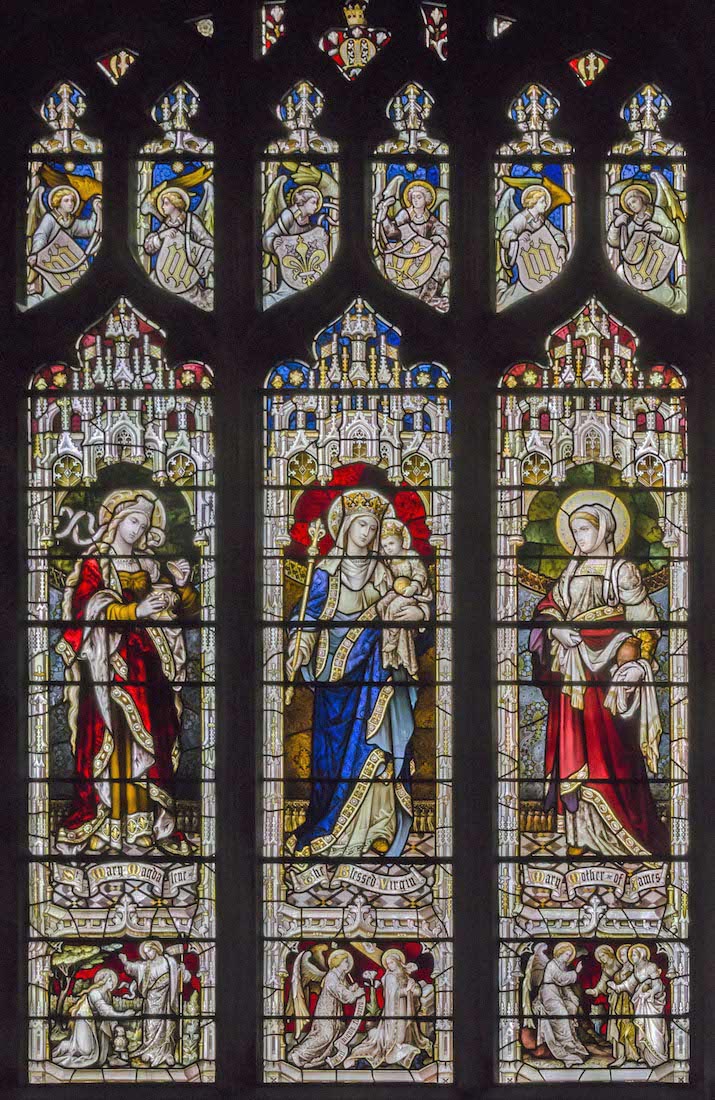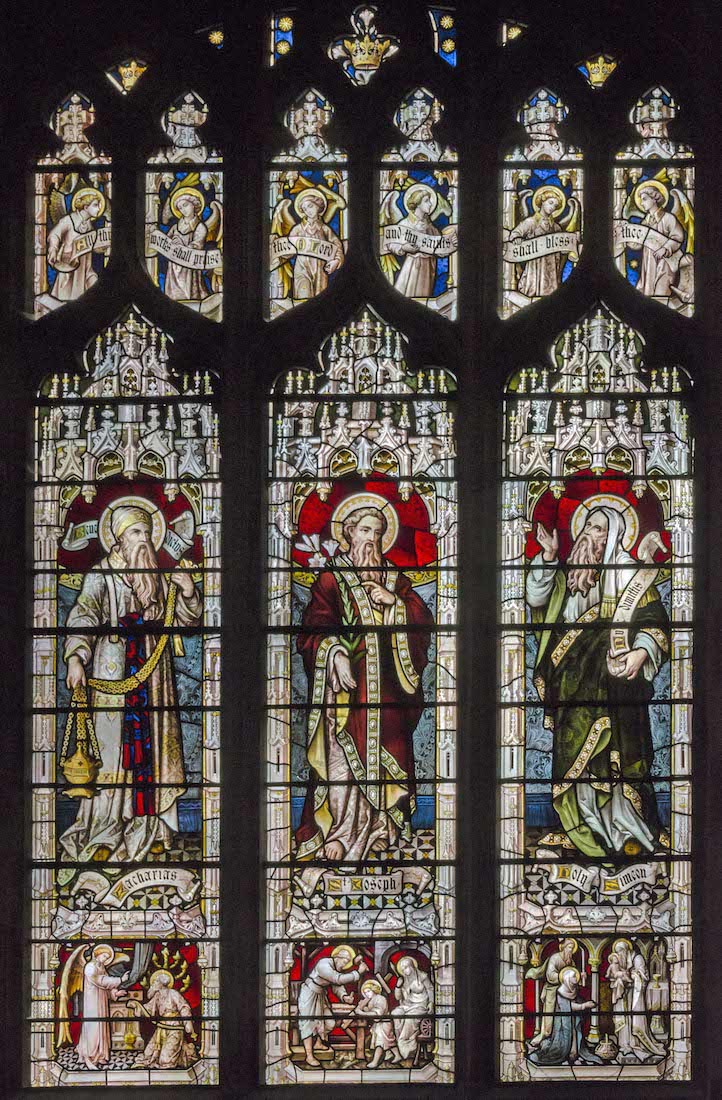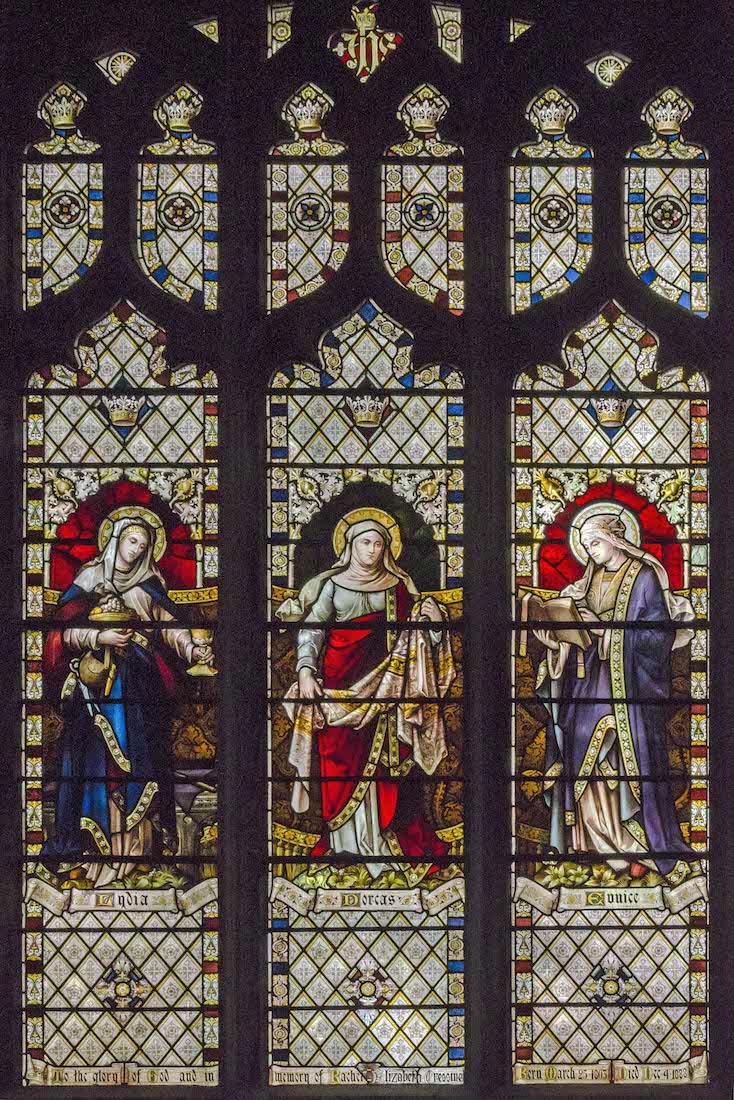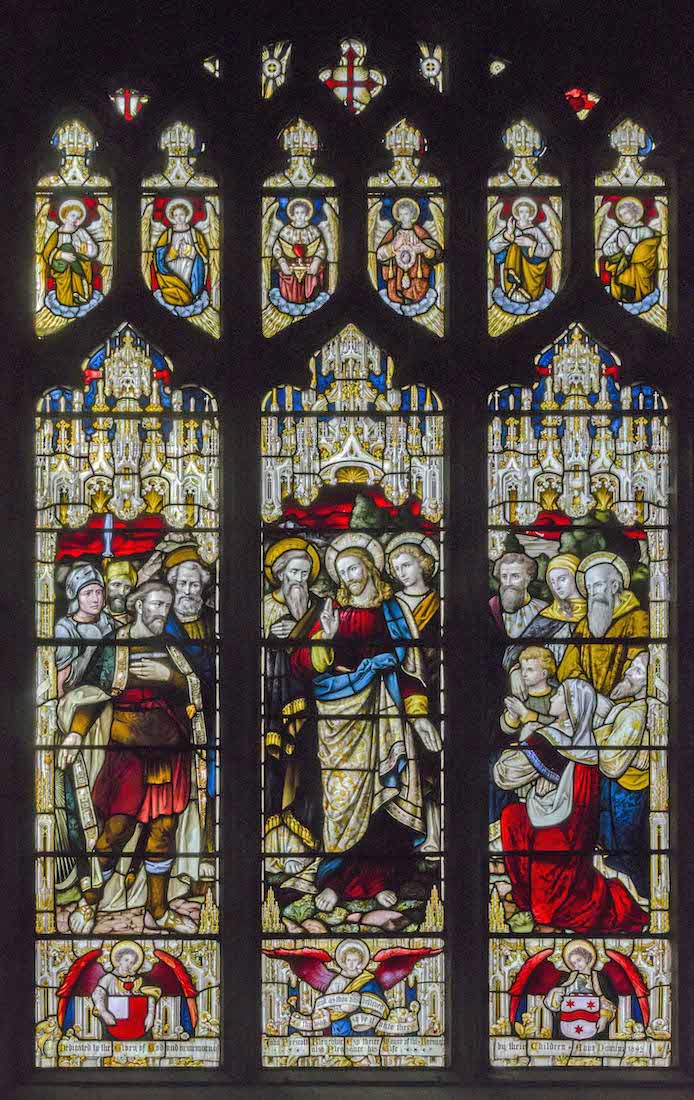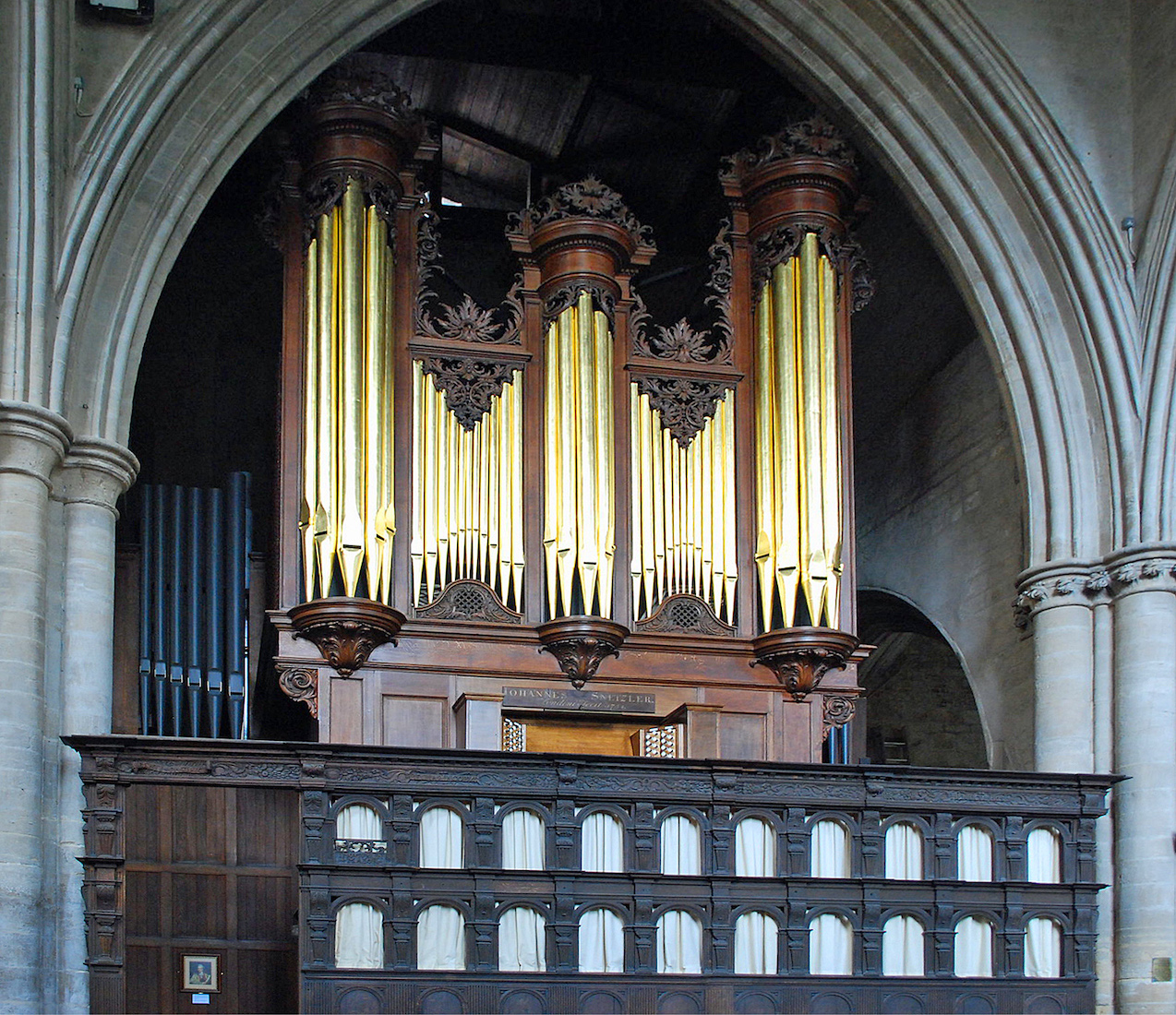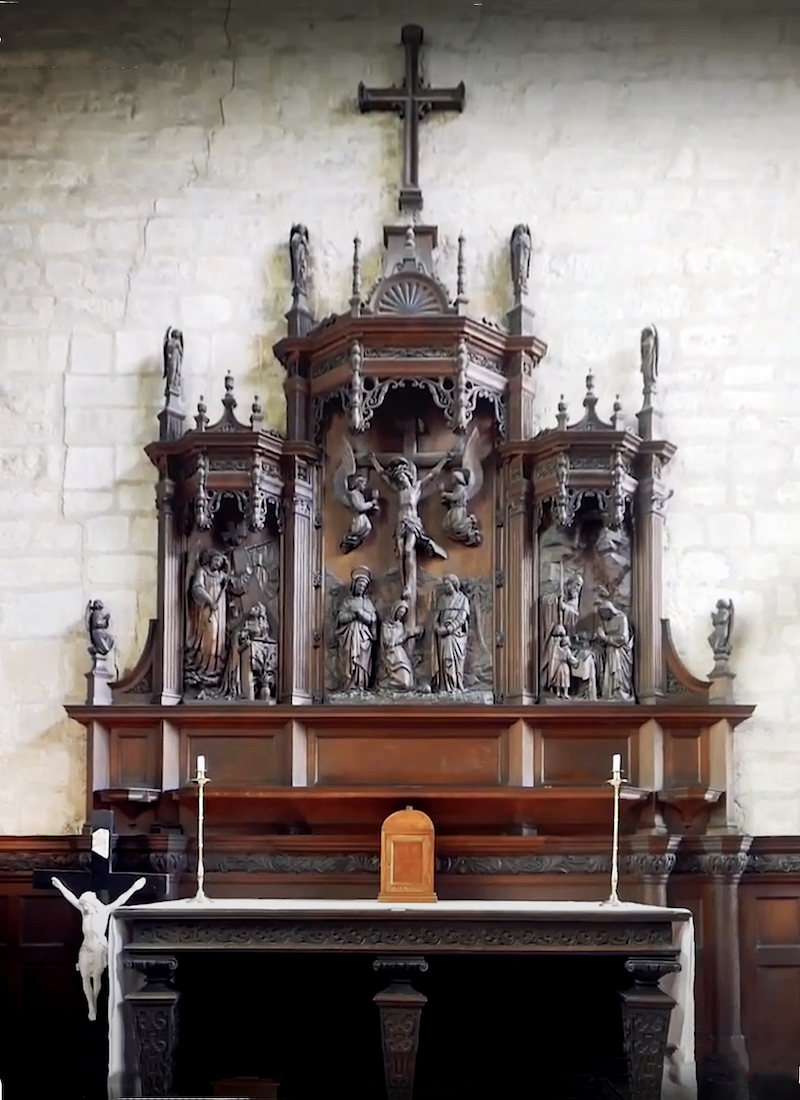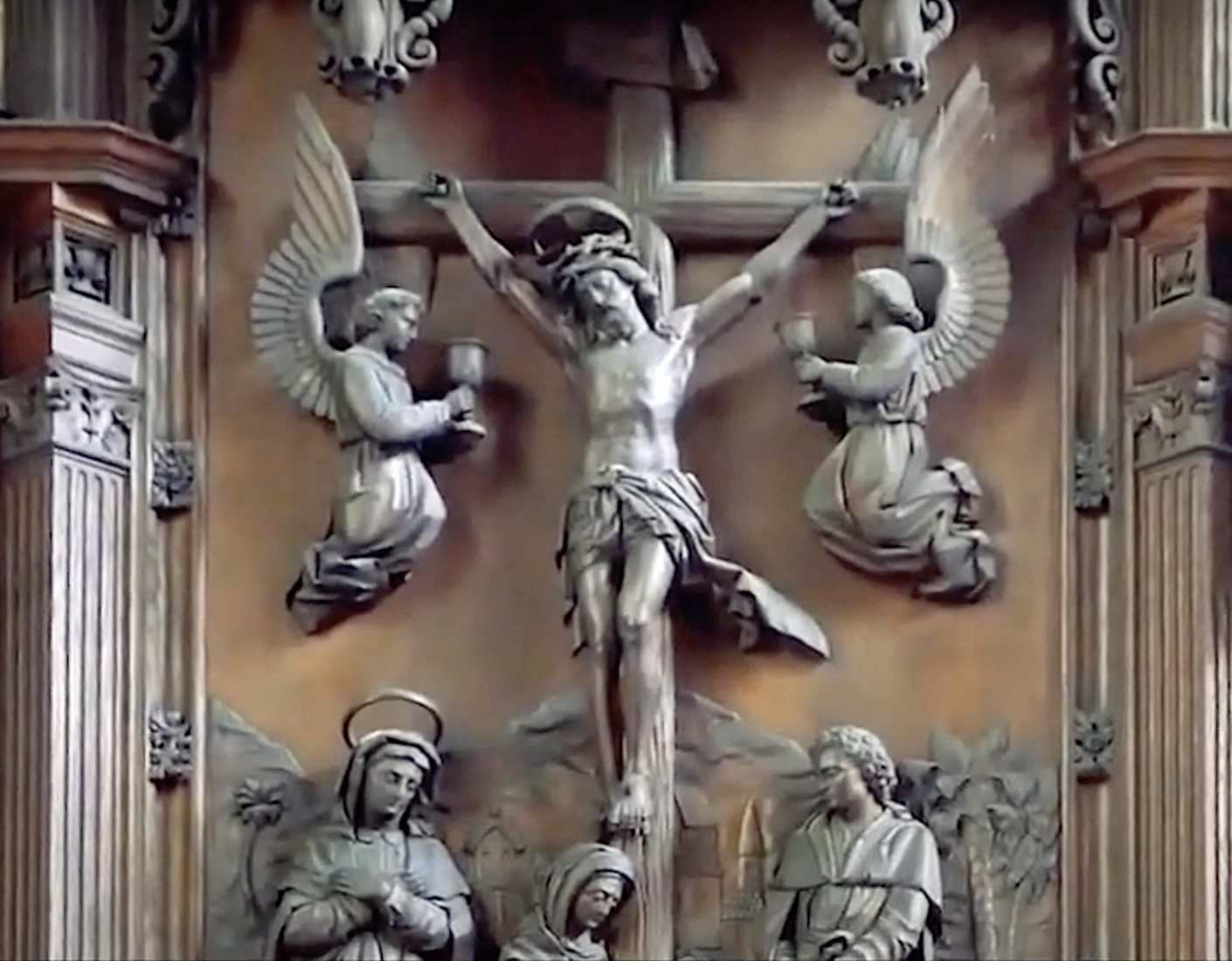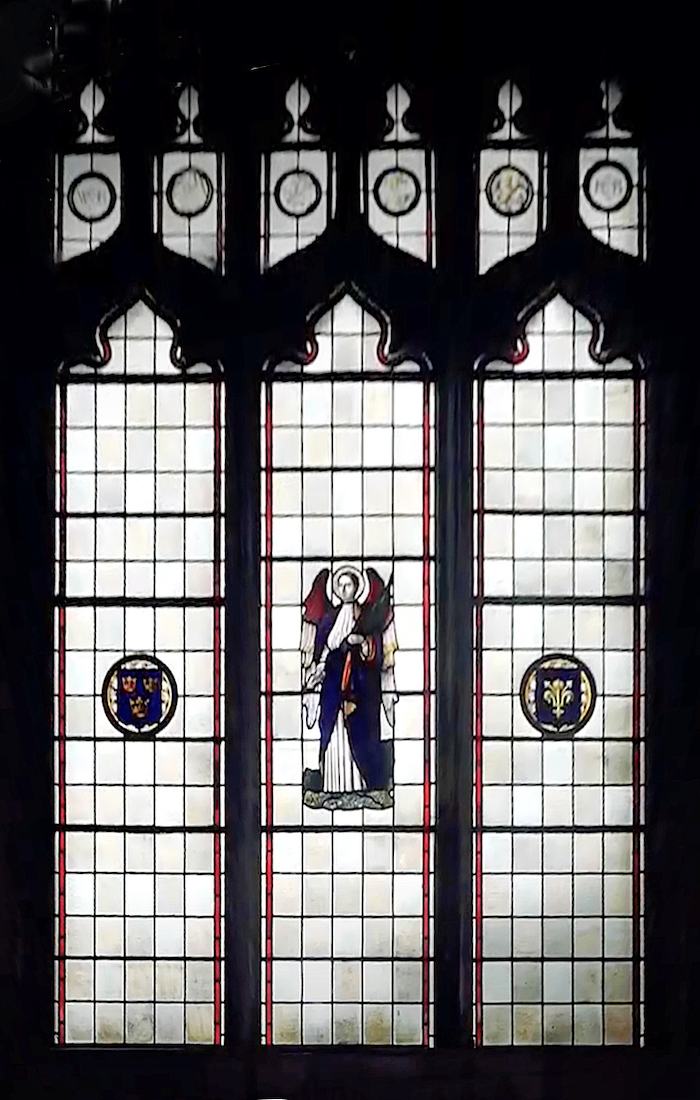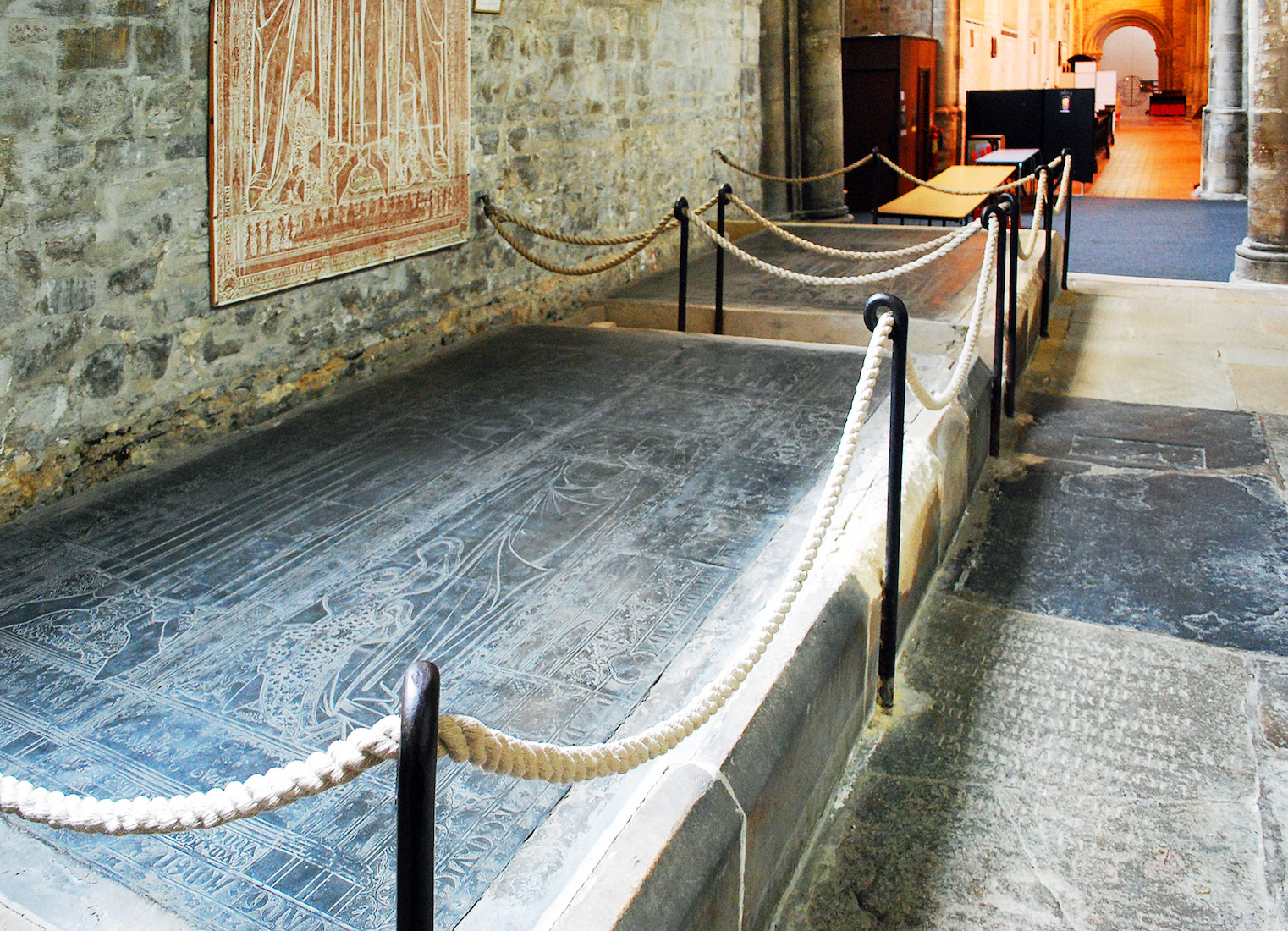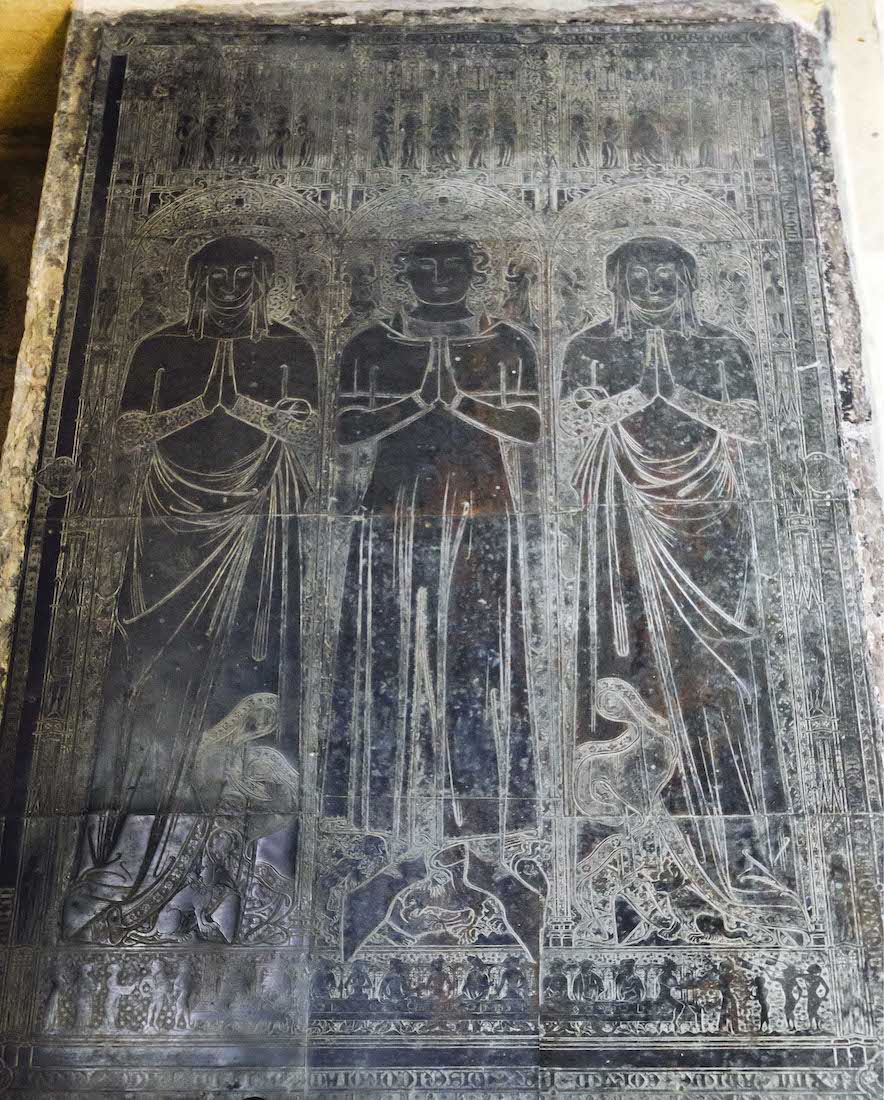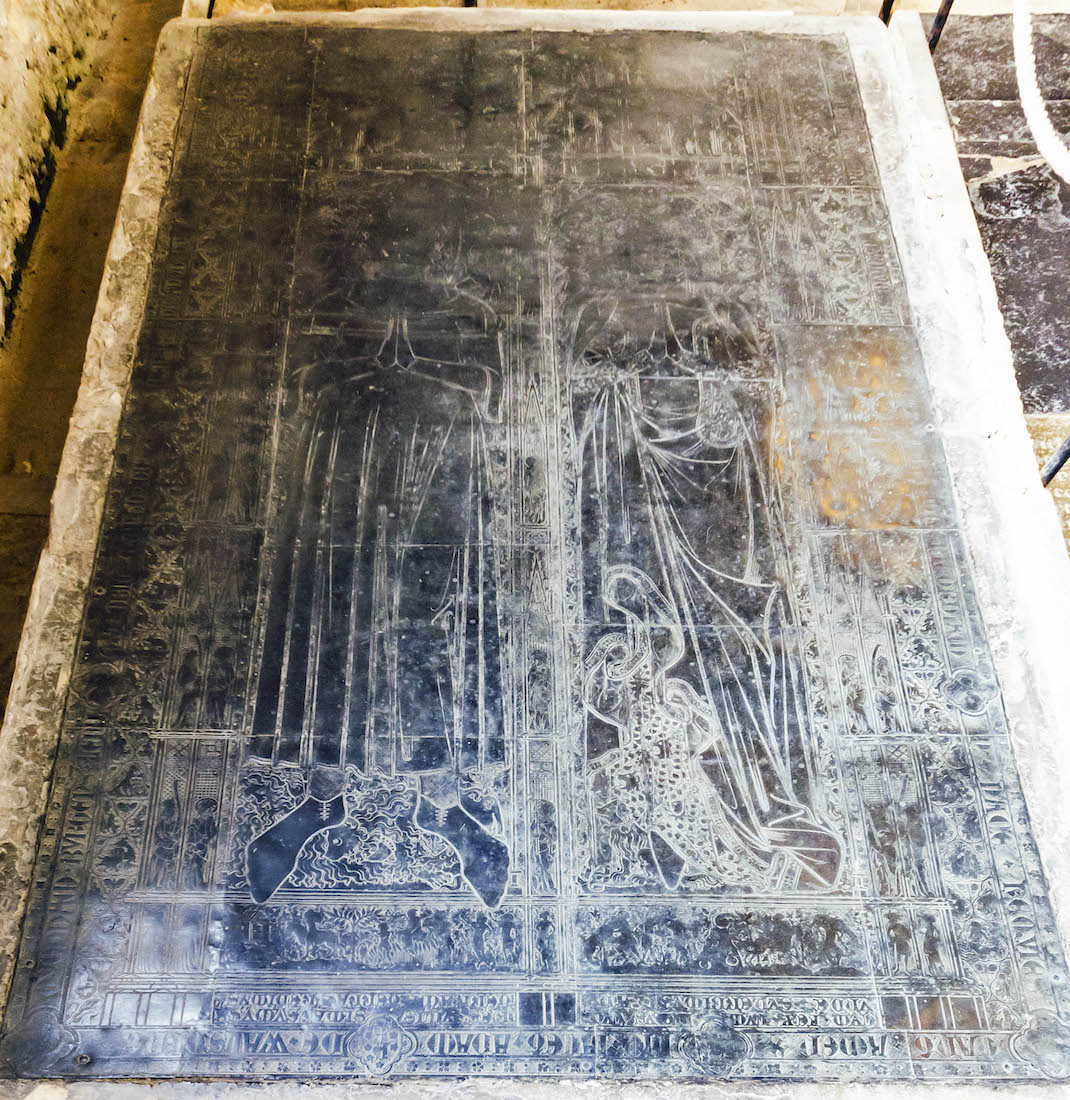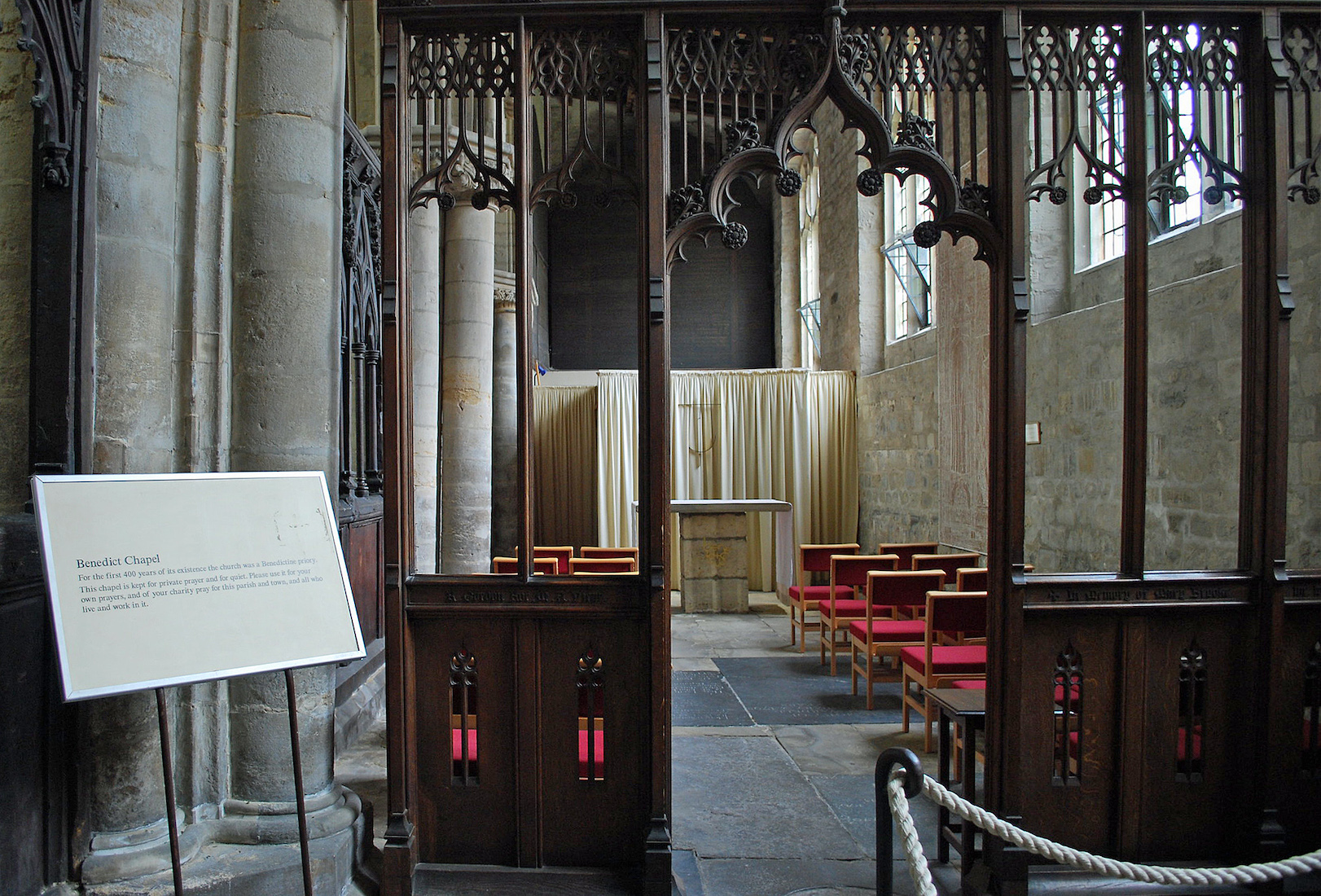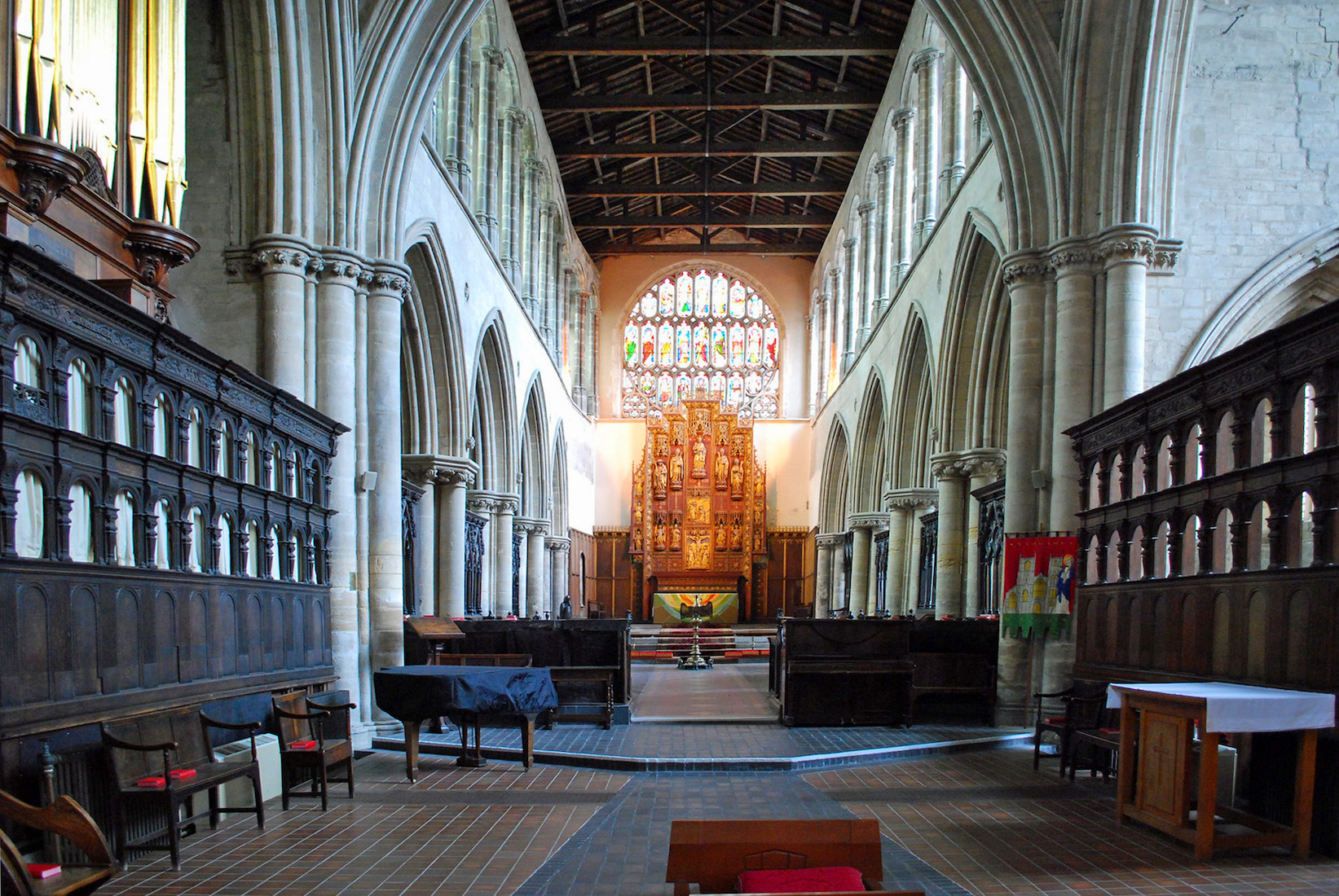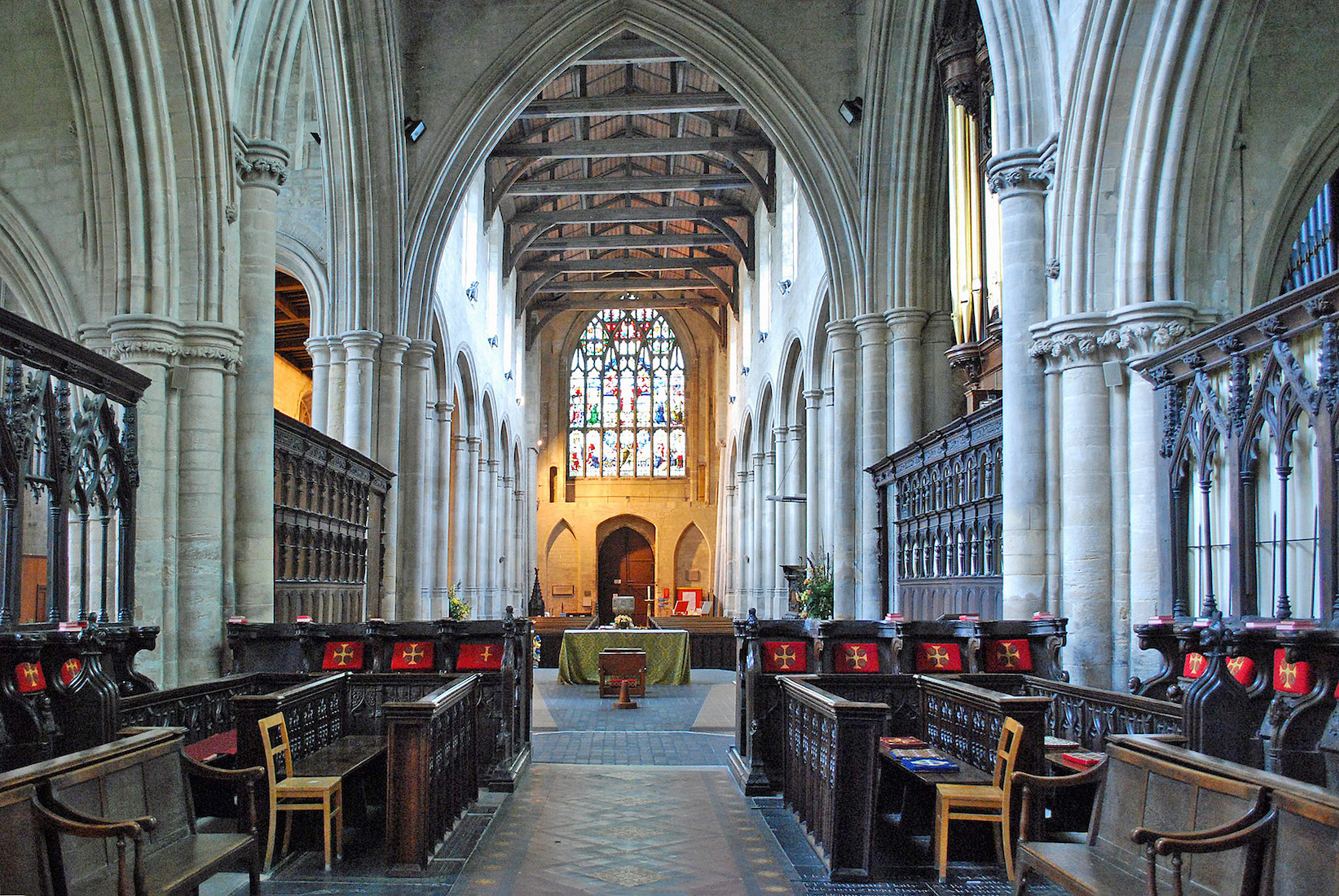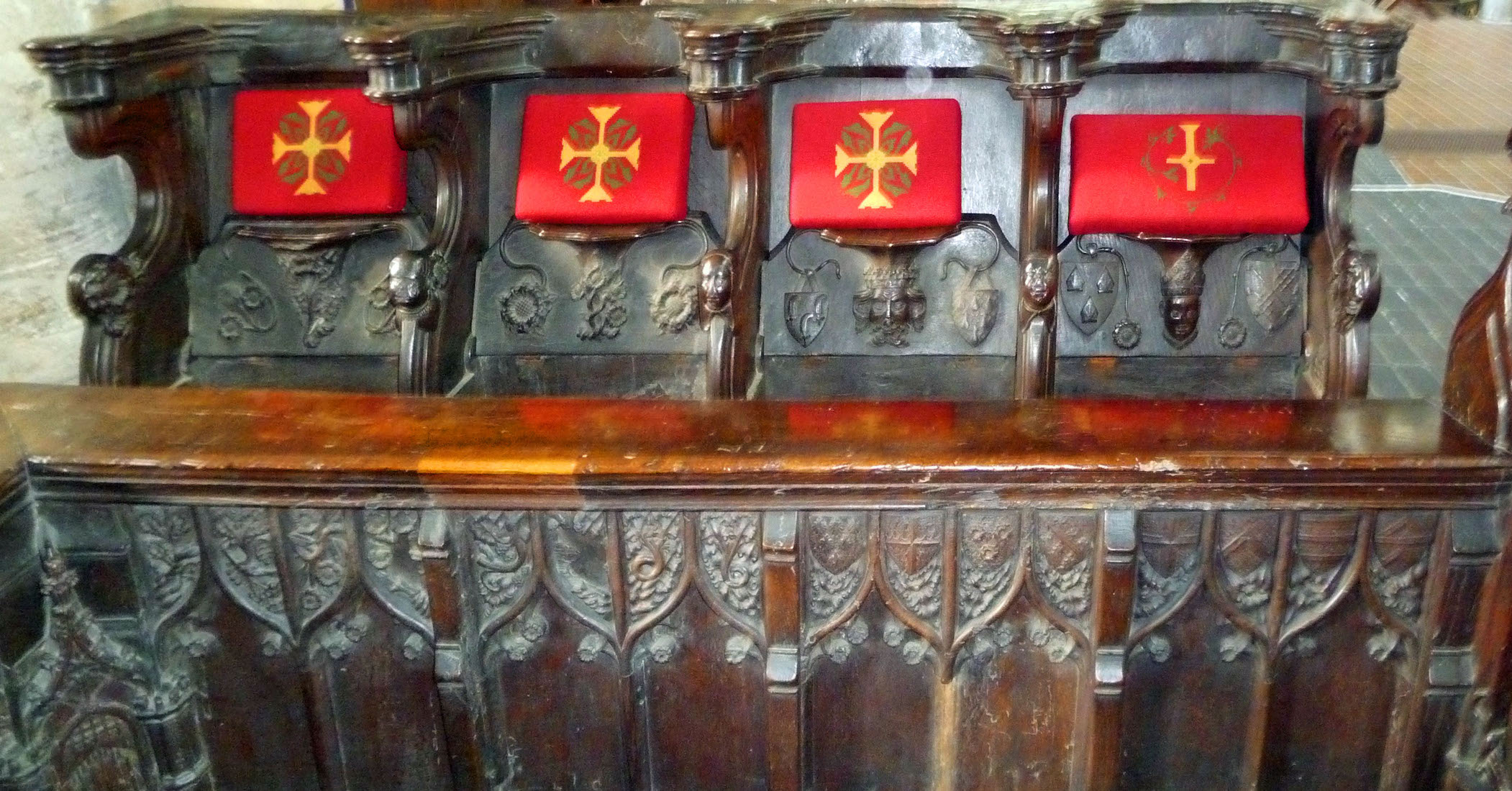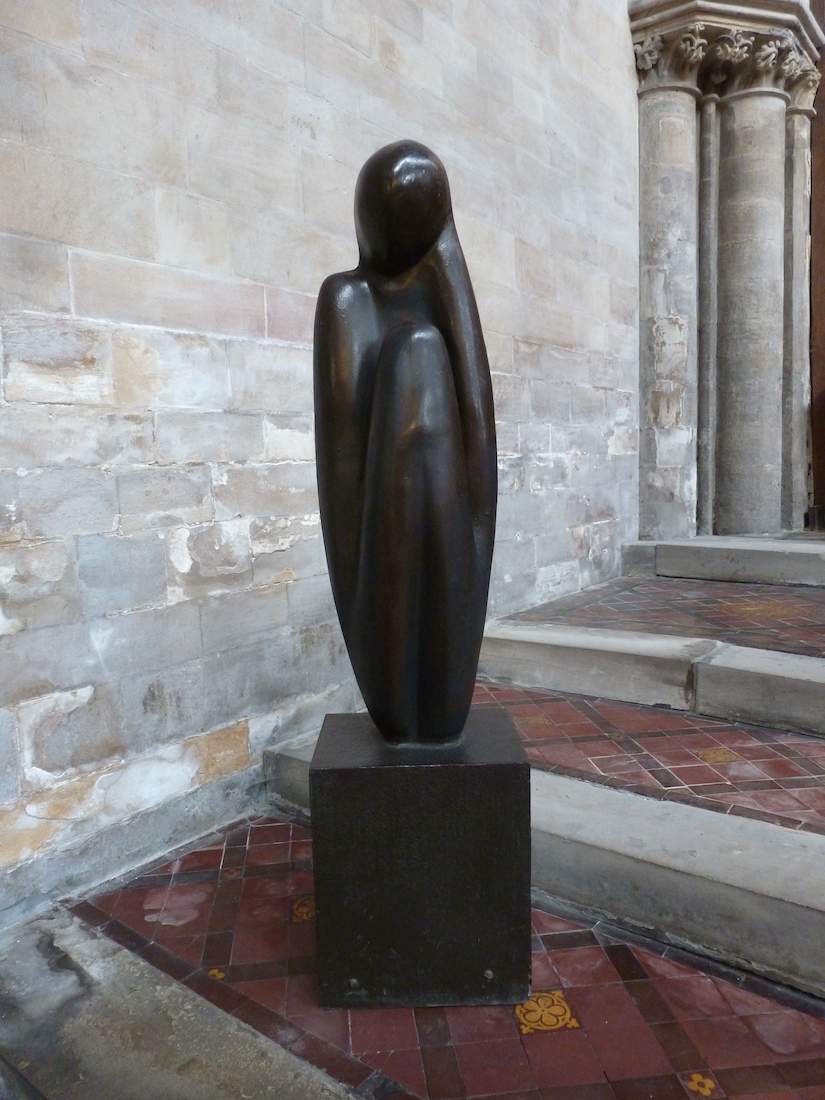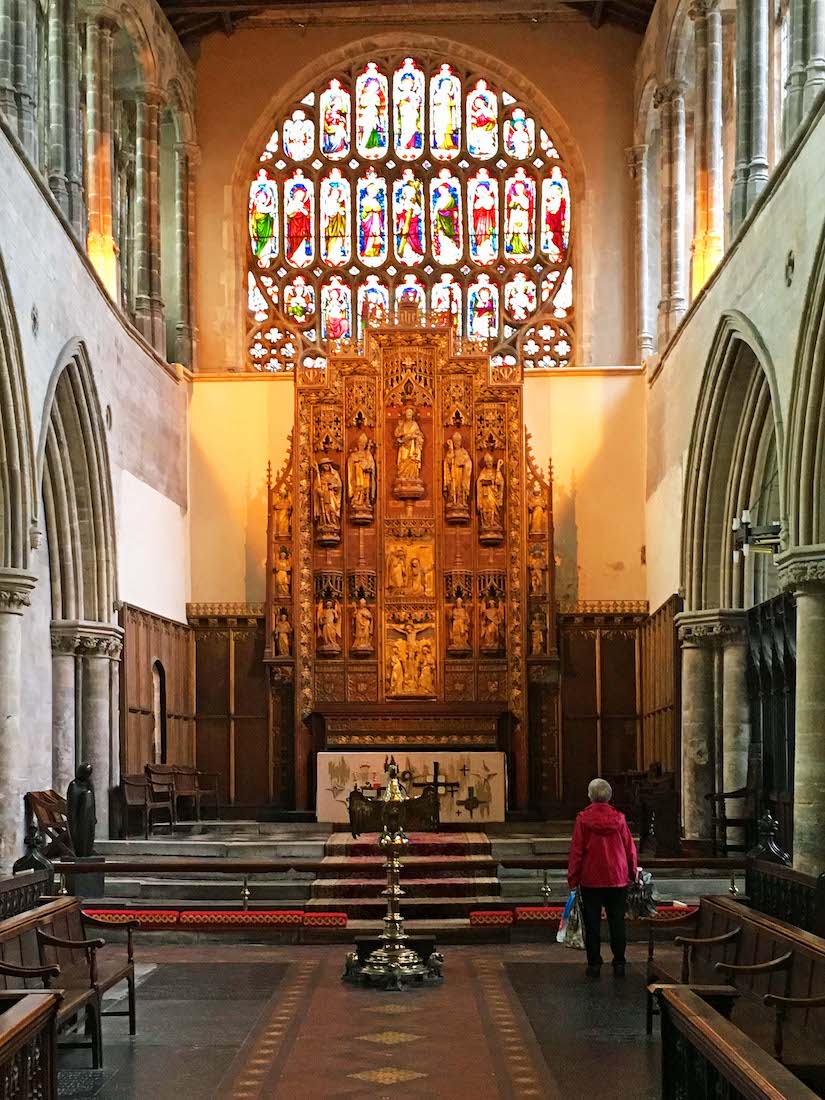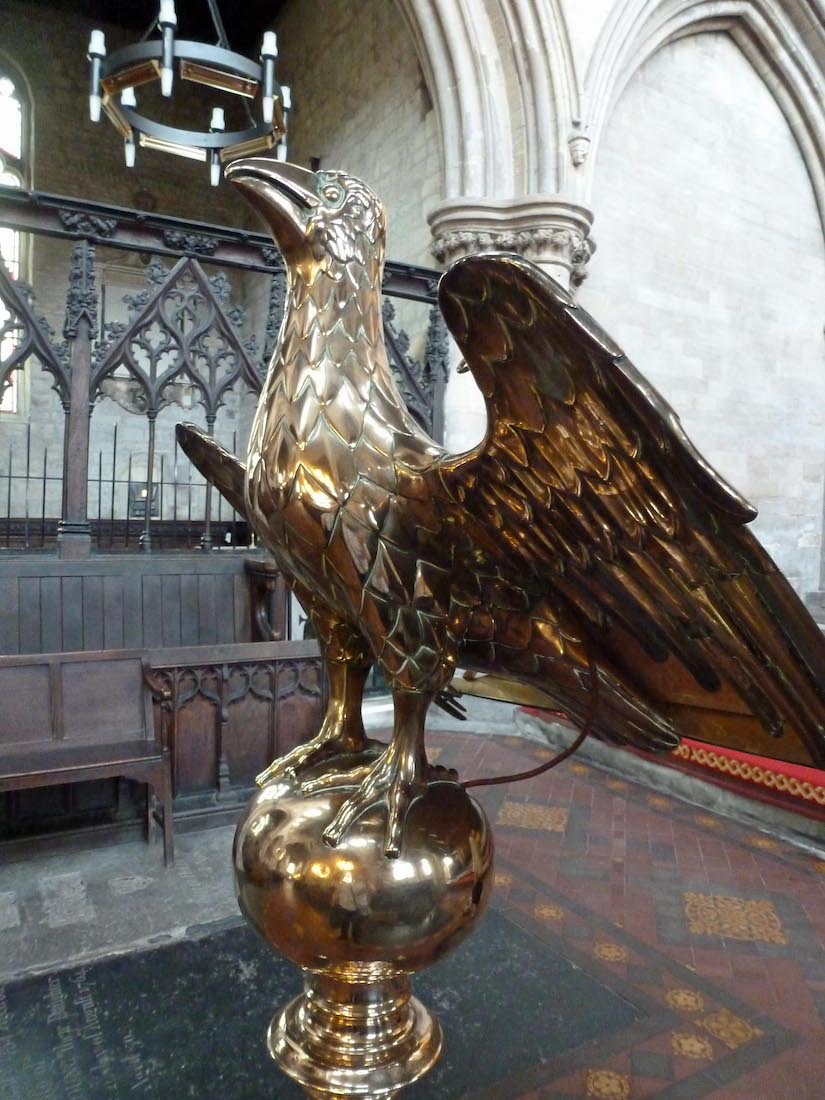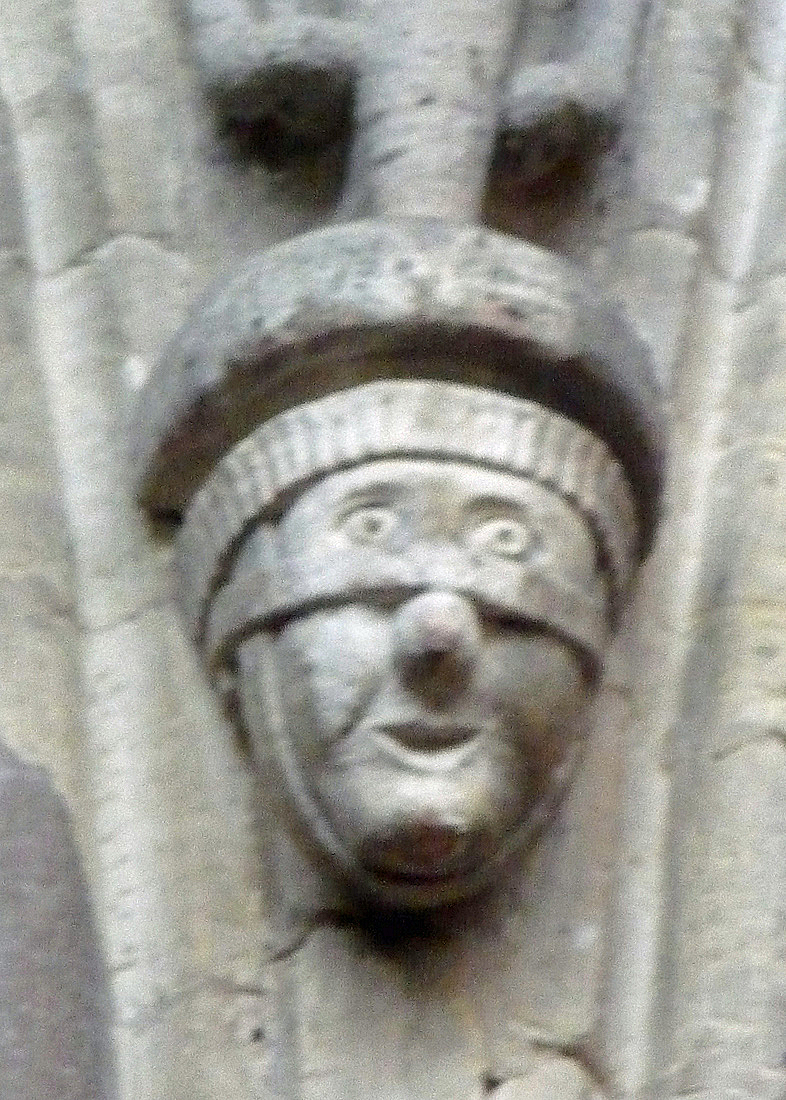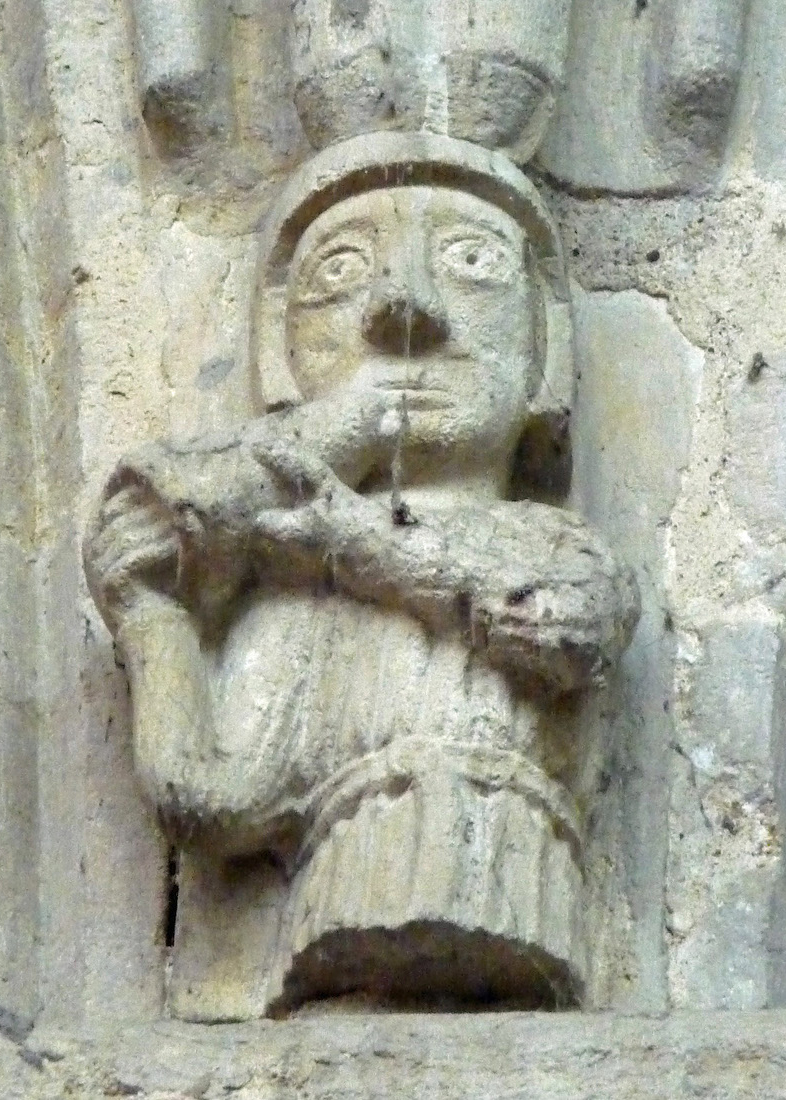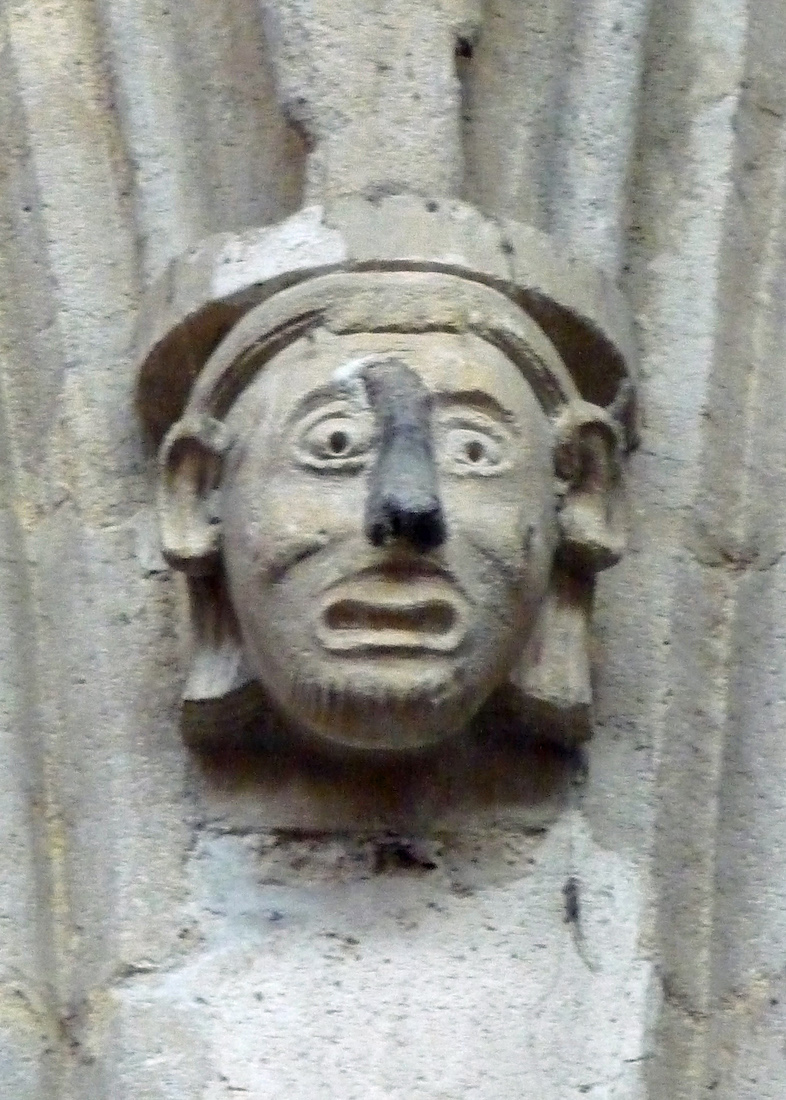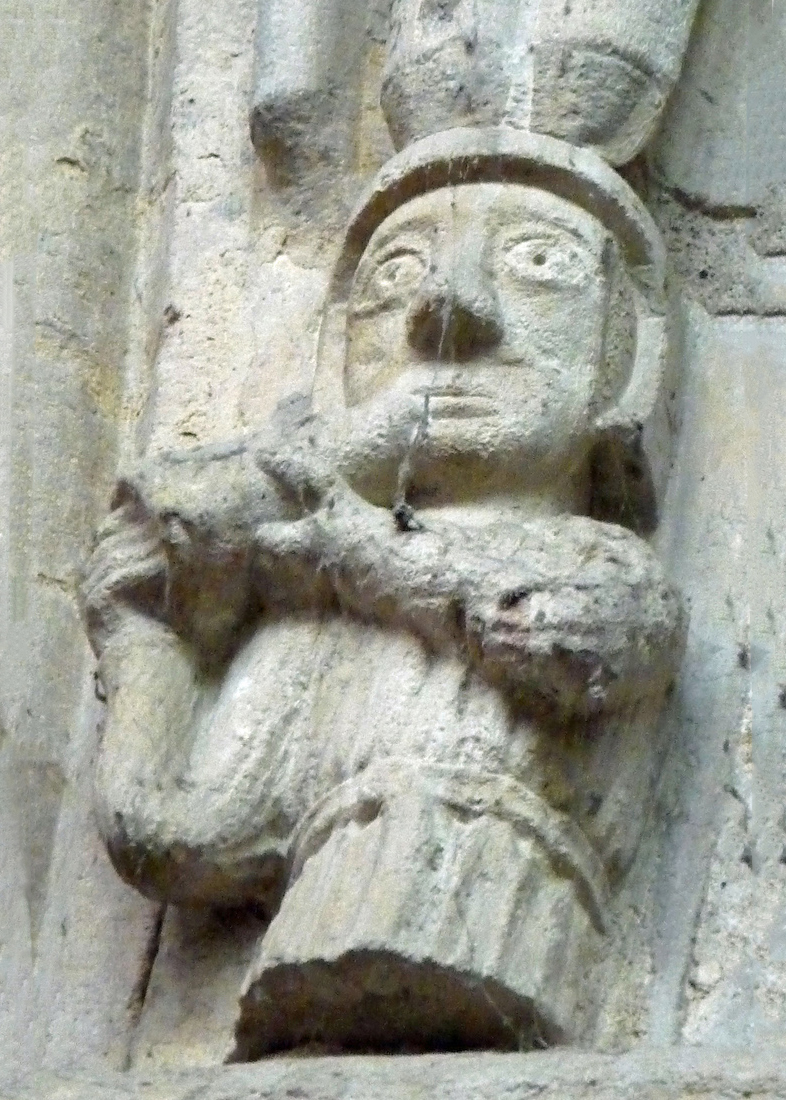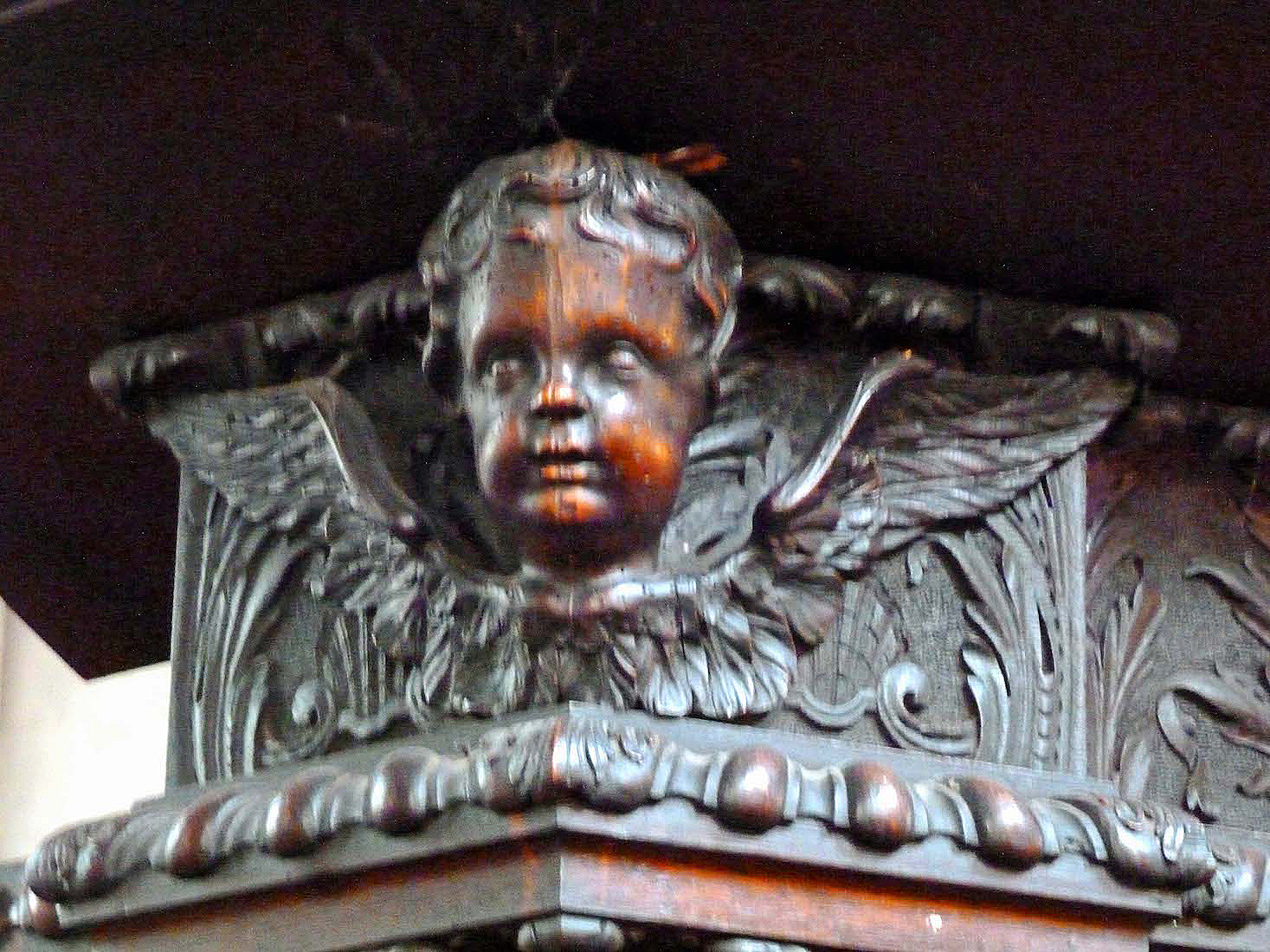
Two angelic faces support the reading platform of the pulpit. I remember that the pulpit of Derby Cathedral has similar angelic faces, but there are probably many others too. INDEX
42. PULPIT CROSS JJM JJM
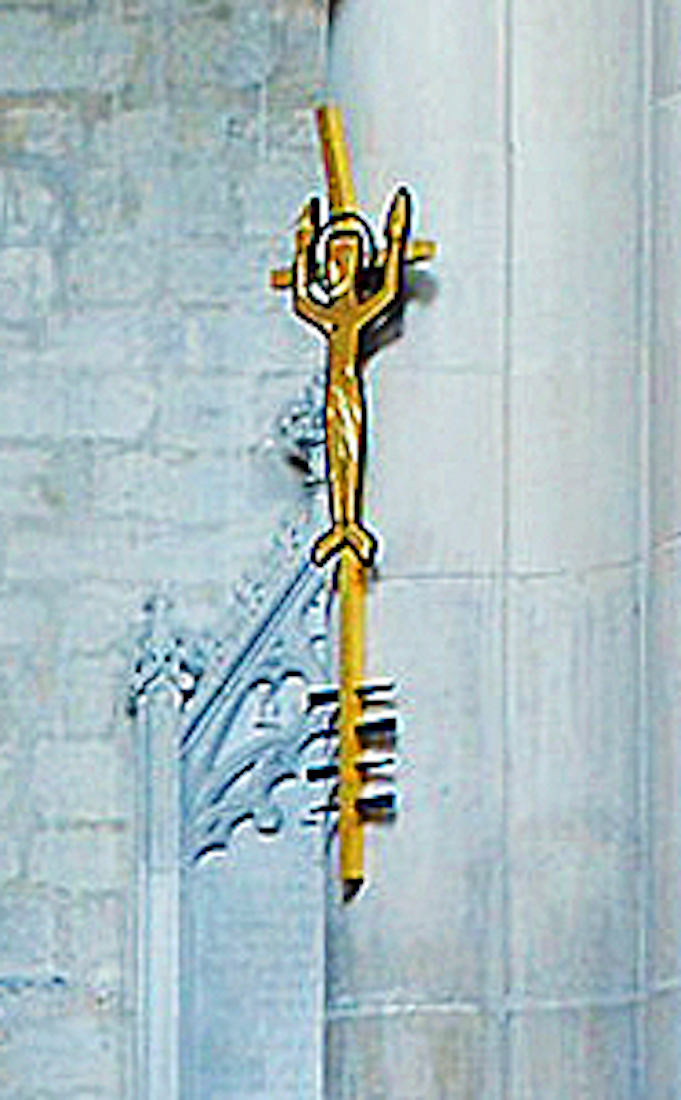

A unique metal Cross hangs on the column behind the pulpit. The story of this Cross featuring the Warrior Christ is told in the accompanying information sheet, attached to the column below the Cross.
43. NAVE ALTAR GA
The nave altar (table) is a simple structure. If we happen to visit in the Easter season we may well find a Tomb Garden laid out beneath it.
44. CIVIC RACK GA
On this column near the mayor’s pew, is a rack for the King John sword, as the town sword is known. It is part of the town regalia and is carried befor the mayor during processions. It rests on the rack during civic services, held by the hand.
45. TO THE SOUTH AISLE JJM
From the nave altar, we move across to the South aisle. On the way we pass the King’s Lynn coat of arms attached to the front pew.
46. LINN COAT OF ARMS ON FRONT PEW GA GA
St Margaret’s designation as patron saint of expectant mothers (particularly in difficult labour) and her emblem, a dragon, are based on one of her trials: Satan, disguised as a dragon, swallows Margaret who is carrying a cross; his stomach, however, soon rejects her, opens, and lets her out unharmed when the cross she carries irritates the dragon’s innards. The King’s Lynn arms contain an allusion to the old Christian story of the pelican feeding its young with blood drawn from its breast, but there are other references to the dragon and cross of St Margaret.
47. SOUTH AISLE WINDOWS I J&J J&J J&J
There are five stained glass windows on the South wall of the nave. We start from the left (East): The Nativity Window with scenes from Christ’s birth and infancy – the Annunciation, Nativity and Presentation. Glass by Clayton & Bell, c.1901. In memory of George Archdale, 1817-1901. • Three Marys – the Virgin Mary in the centreMary Magdalene, and Mary the mother of James, and below scenes from their lives. In memory of another Mary, the sister of Emma and Jane Balding, who died in 1888. • Zacharius, Joseph and Simeon with related scenes in the panels below. In memory of Edwin Elmer Durrant, d. 1885. He was sometime Mayor of Lynn.
48. SOUTH AISLE WINDOWS II J&J J&J
From left, these remaining windows in the South aisle depict: • Three New Testament women: Lydia, Dorcas and Eunice; in memory of Rachel Elizabeth Cresswell who died in 1888 aged 85; • Jesus healing the Centurion’s daughter (1892); in memory of John and Pleasance Blencowe. Some of the details of these South windows can be found here, and some of the lower panels here. We now walk back across the Minster to where the organ extends from the shallow North transept.
49. ORGAN JJM
The Minster organ is one of the most written-about organs and it is without doubt a landmark in the development of organ building in England. This is John Snetzler’s first large instrument, only ever exceeded by a small margin by his organ for Beverley Minster. After its installation in 1754, the organ was acclaimed the finest in the country. It is a claim too often made for many organs, but in this case, one affirmed by Holdich when he repaired and added pedals to the organ 100 years later. It established Snetzler’s reputation as the leading organ builder of the second half of the 18th century and his position as organ maker to the King. The organ case has its own importance. It was made by Snetzler’s brother Leonard in the grandest rococo style. Although above the impost only the façade is intact, it is one of the finest surviving 18th century organ cases. In the immediate foreground there is a Tudor screen. The lower part consists of blank arcading, while above there are two levels of open arches. It is dated 1584, and records that Thomas Gurlin, the mayor, was perhaps the donor, as well as also recording that James I became king in 1603. The wood is a delicious chocolatey brown, as evocative of its age as the 14th century screen in the chancel.
50. TRINITY CHAPEL REREDOS KLM
Following the North aisle Eastwards beyond the organ brings us to the Trinity Chapel. This is now used as a vestry, and is not generally open to the public. This is a shame because the reredos is exquisite. The Annunciation is pictured at left, at centre is a Crucifixion scene, and at right is a Nativity scene.
51. CRUCIFIXION KLM KLM
Here is a close-up of the central panel of the reredos. The window at right is in the North wall of the Chapel.
52. SOUTH SIDE BRASSES JJM
In the South aisle East of the crossing are two large brasses. These are the two largest brasses in England, but they were probably made in Germany or the Low Countries. The earliest is in memory of Adam de Walsoken, who died in 1349, and the other is for Robert Braunche, who died in 1364. Both men were Mayors of the town.
53. BRASS DETAILS J&J J&J
At left is the 14th century brass for Robert Braunche (d. 1364), a wealthy merchant. He is depicted with his first and second wives Letitia and Margaret. Below the feet of the three figures is a peculiar scene known as The Peacock Feast. At right is the brass for Adam de Walsoken (d. 1349) and his wife Margaret. Walsoken owned several large properties in King’s Lynn. What really makes his brass memorable is a countryside scene below the couple’s feet, with a very clear image of a 14th century post mill.
54. ST BENEDICT’S CHAPEL JJM
At the Eastern end of the South aisle is St Benedict’s Chapel. Originally in 1095, the Church was established by Herbert de Losinga, Bishop of Norwich to serve a Benedictine Priory and dedicated to St Margaret of Antioch. The priory was subordinate to the Priory of the Holy Trinity in Norwich.
56. CHOIR STALLS LOOKING WEST JJM
This is a view back to the West window from the 14th century choir stalls. Records show that the stalls were made between 1375 –1376.
57. CHOIR STALLS GA
The stalls are decorated with carved heads, including Edward, the Black Prince, and Henry Despenser, Bishop of Norwich. The stall seats retain some wonderfully carved misericords, or ‘mercy seats’ to support clergy while standing during long services. We can take time here to look more closely at the choir misericords, and also the carved decorations on the stalls.
58. BLACK MADONNA AND SANCTUARY GA PRS
A modern sculpture of the Blessed Virgin and child has been intelligently placed to the North of the sanctuary. It is called ‘Refugee’ and was made by Naomi Blake in 1990. It is dedicated to All Victims of Oppression. The sanctuary itself with high altar, reredos, and East window is quite overwhelming. Keen eyes will notice the small heads above the side column capitals
59. LECTERN GA GA
Standing before the high altar in the middle of the chancel is one of those big latten eagle lecterns with lion feet, so familiar from this part of Norfolk. The lectern is the place from where the Scripture is read.
60. CARVED HEADS GA GA GA GA GA GA
Here are six heads appearing near the join of the chancel arches, just above the column capitals.


